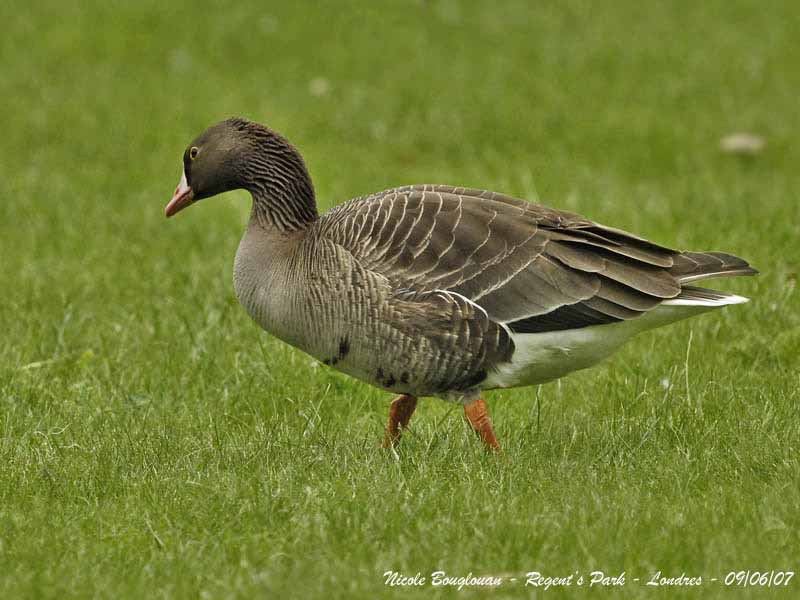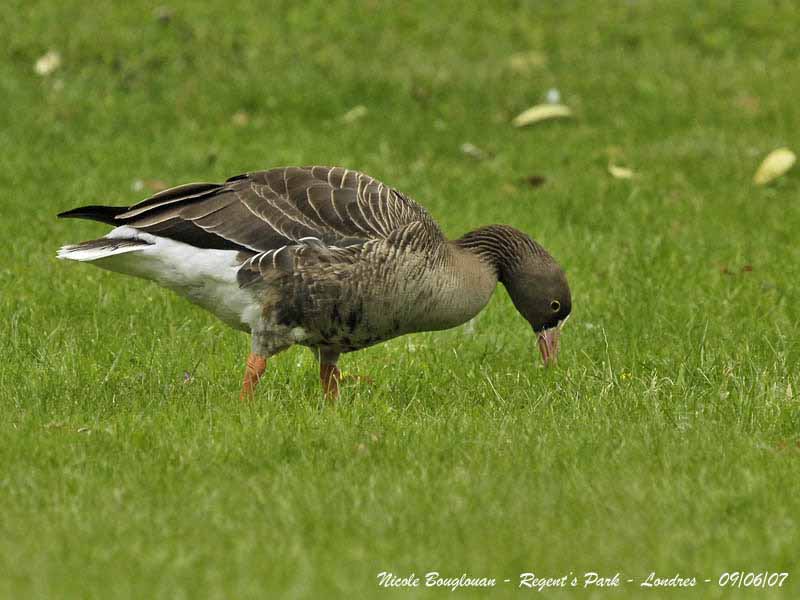
Lesser White-fronted Goose
Anser erythropus
Anseriforme Order – Anatidae Family
BIOMETRICS:
Length: 53-66 cm
Wingspan: 120-135 cm
Weight: M: 1950-2300g – F: 1400-2150g
DESCRIPTION:
Lesser White-fronted Goose is difficult to separate from similar race Greater White-fronted Goose.

Lesser White-fronted Goose has brown plumage, darker than that of Greater, mainly on head, neck and upperparts. Underparts have smaller dark patches than in Greater. We can see a white border line between flank and wing, brighter than in Greater. In Lesser, longer wings are projected beyond tip of the tail when closed.
Lesser White-fronted Goose has smaller, shorter and brighter pink bill; head is more rounded; body and neck are shorter. It has bright yellow eye-ring. Adults have white face patch extending a little further up onto forecrown than Greater, ending above eye.
As in Greater, legs may appear distinctly pinkish at times.
Both sexes are similar.
Juvenile is brown, but darker than juvenile Greater. It has dusky nail and shading on the bill. It is darker overall and lacks white face and black belly patches.
VOICE: SOUNDS BY XENO-CANTO
Lesser White-fronted Goose may utter some loud calls, mainly on breeding grounds. Alarm call is a grating “kiou-oop”. Flight calls are quicker and higher in pitch than in Greater, including phrases such as “kyee-yeek” or a repeated “kyu-yu-yu”.
HABITAT:
Lesser White-fronted Goose breeds in moist wooded tundra with bushy thickets, at the edges of taiga, near coasts, in islands, on foothills and mountain lakes.
It winters in salt steppes, farmlands and meadows, and favours more semi-arid country than Greater.
RANGE:
We can find three main sub-populations of Lesser White-fronted Geese.
Central Asian or Caspian populations, breed in European Russia and Central Asia, and winter in the Black Sea region.
East Asian populations breed in eastern Siberia and winter in China.
The smaller European populations breed in Norway and the Kola Peninsula (Russia) and winter in Greece and Turkey.

BEHAVIOUR:
Lesser White-fronted Goose arrives in breeding areas in May. Pairs defend territories. At this moment, they feed in green stems and blooms of grasses and sedges. During migrations and winter, they consume mainly seeds. They graze by rapid movements and forage in shallow water.
After post-breeding moult, Lesser White-fronted Goose starts to migrate in late August-early September, and arrives in winter areas from mid-October to mid-December. They perform sometimes prolonged stopovers. They are gregarious outside of breeding season.
They may gather with other goose species in large lakes and streams. Lesser White-fronted Goose is relatively agile on ground, and often runs short distances.
Mixed pairs with Greater White-fronted Goose and Lesser White-fronted Goose have been noticed, but hybridizations are unsuccessful and not really sure.
FLIGHT:
Lesser White-fronted Goose flies with slightly faster wing beats than Greater, and has more compact silhouette.
REPRODUCTION:
Lesser White-fronted Goose’s nest is a scrape in the ground, at deserted foothills, close to lakes or rivers. Geese arrive on nesting areas in late May, when most of territories are still covered with snow.
Female lays 3 to 4 eggs. Incubation lasts about three weeks, by female. Young usually fledge in late August.
They remain in family group during the first year, and follow their parents, studying with them the migration ways.
Geese families are known for their unity. Pair bonds last all their life, and if one of them dies, the other stays lonely.
DIET:
Lesser White-fronted Goose feeds mainly on plant matter, such as grass, moss and seeds.

PROTECTION / THREATS / STATUS:
Lesser White-fronted Goose is an endangered species. The most important cause of their decline is the high mortality due to hunting on winter areas. Habitat loss and disturbances, intense predation in breeding areas, are other reasons of this decline. Degradation and conversion of wetlands to arable lands are important threats for this species.
Several projects for secure suitable habitat in breeding areas, control of hunting and poaching in winter areas, and halt the decline of populations, are the aims for saving this beautiful species.
Scandinavian experts try to protect breeding birds in special farms. Russian experts make efforts to protect the birds during each period if their life. But many birds die during wintering, and they are easy prey for hunters. In 2000, about one thousand birds died in China, due to toxic corn scattered in fields.
All ornithologists have been working and are still working on methods to restore and protect the world population of Lesser White-fronted Goose.
Fr: Oie naine
All : Zwerggans
Esp : Ansar Chico
Ital : Oca lombardella minore
Nd : Dwerggans
Russe : Пискулька
Sd : Fjällgås
Texte et photos de Nicole Bouglouan
Sources :
GUIDE DES CANARDS, DES OIES ET DES CYGNES – de Steve Madge - Delachaux et Niestlé - ISBN: 2603013769
HANDBOOK OF THE BIRDS OF THE WORLD vol 1 by Josep del Hoyo-Andrew Elliot-Jordi Sargatal - Lynx Edicions - ISBN: 8487334105
Wikipedia (Wikipedia, The Free Encyclopedia)
BirdLife International (BirdLife International)